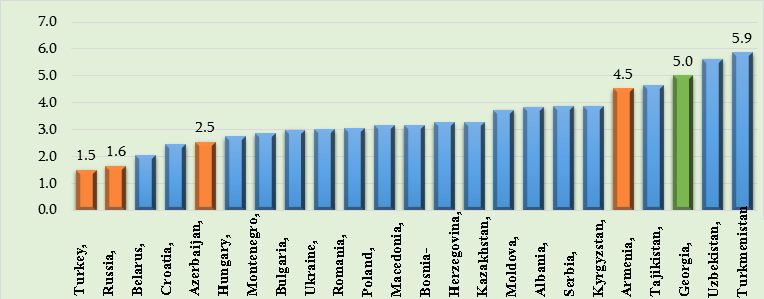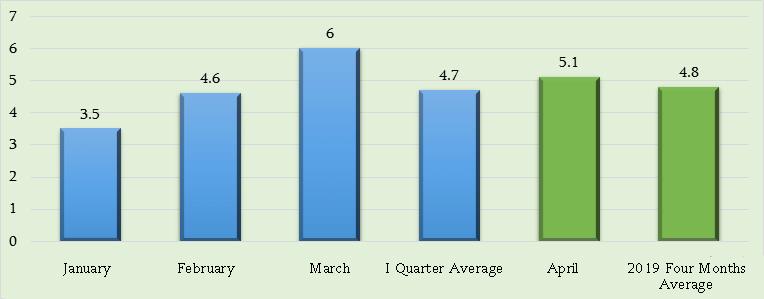Resume: The International Monetary Fund publishes economic growth forecasts. Mamuka Bakhtadze focuses on the next four years and so 2019-2023 should be selected for analysis. In the given period, Georgia’s estimated average economic growth is 5% whilst the average economic growth in the neighbouring countries is 2.5%. Georgia’s expected economic growth is precisely twice as large as that of the neighbouring countries. However, in light of the low economic growth rate of our other neighbours which stipulates the low average figure for the entire neighbourhood, of note is that Armenia’s estimated economic growth is in essence not lower than Georgia’s and, in fact, it outperformed us in the last two years.
In regard to the region, it is appropriate to clearly define the region where Georgia belongs and this is relevant for comparison. In accordance with the World Bank’s methodology, Georgia is in the group of European and Central Asian countries. In this region, the country can indeed be considered as one of the leaders (although not a top leader) with an estimated 5% average economic growth rate which is the third highest economic growth rate. Therefore, the Prime Minister’s statement does not fully reflect the reality and his audience might have a manipulated impression about the real situation.
In accordance with the International Monetary Fund, Georgia’s estimated economic growth rate for 2019 constitutes 4.6%. As given in the preliminary assessment, the real gross domestic product (GDP) growth in April 2019 was 5.1% as compared to the same period of the previous year whilst the average real GDP growth for the first four months of 2019 constitutes 4.8%.
Analysis
The United States Institute for Peace hosted the third annual US-Georgia Strategic Partnership Conference which was opened by the Prime Minister of Georgia. In his opening remarks, Mamuka Bakhtadze stated: “Georgia’s economic growth rate is 5% on average and is twice as large as compared to the figures in the neighbourhood. In accordance with the International Monetary Fund, in the next four years Georgia will keep this leader position in the region in terms of economic growth.”
The International Monetary Fund publishes economic growth forecasts. Table 1 shows the economic growth dynamic in Georgia’s neighbour countries.
Table 1: Economic Growth in Georgia’s Neighbour Countries
|
2017 |
2018 |
2019 |
2020 |
2021 |
2022 |
2023 |
2024 |
|
|
Georgia |
4.8 |
4.7 |
4.6 |
5.0 |
5.2 |
5.2 |
5.2 |
5.2 |
|
Azerbaijan |
0.1 |
1.4 |
3.4 |
3.1 |
2.1 |
1.6 |
1.5 |
1.7 |
|
Armenia |
7.5 |
5.0 |
4.6 |
4.5 |
4.5 |
4.5 |
4.5 |
4.5 |
|
Russia |
1.6 |
2.3 |
1.6 |
1.7 |
1.7 |
1.6 |
1.6 |
1.6 |
|
Turkey |
7.4 |
2.6 |
-2.5 |
2.5 |
3.0 |
3.0 |
3.5 |
3.5 |
Source: International Monetary Fund
Mamuka Bakhtadze focuses on the next four years and so 2019-2023 should be selected for analysis. In the given period, Georgia’s estimated average economic growth is 5% whilst the average economic growth in the neighbouring countries is an aggregated 2.5%. Georgia’s expected economic growth is precisely twice as large as that of the neighbouring countries. However, of note is that the low economic growth rate of the neighbourhood is stipulated by the low economic growth rate of our other neighbours whilst Armenia’s figures in essence are not lower than those of Georgia’s.
In regard to the region, it is appropriate to clearly define the region where Georgia belongs and this is relevant for comparison. In accordance with the World Bank’s methodology, Georgia is in the group of European and Central Asian countries (excluding the high income countries). The economic characteristics of the countries in this group are more or less similar.
Graph 1: Estimated Average Economic Growth Rate (%) in the Region in 2019-2023

Source: World Bank, International Monetary Fund
As illustrated by the graph, Georgia can be considered as one of the leaders in the region with an estimated 5% average economic growth rate which is the third highest economic growth rate.
In regard to 2019’s data in accordance with the World Bank’s document published in January, Georgia’s estimated economic growth rate was 5% although the estimate was slashed to 4.6% in the subsequent report. Similarly, the International Monetary Fund’s forecast for Georgia is also a 4.6% growth rate. The deterioration in external economic factors; that is, a decreased foreign demand, on the one hand, and the negative impact of lending regulations, on the other hand, were behind the decision to cut the estimated economic growth rates. See FactCheck’s research on this topic.
Graph 2: Assessment of 2019 Economic Growth Rate vis-à-vis the Respective Period of the Previous Year (%)

Source: National Statistics Office of Georgia
In accordance with the preliminary assessment, the real gross domestic product (GDP) growth in April 2019 was 5.1% as compared to the same period of the previous year whilst the average real GDP growth for the first four months of 2019 is 4.8%. The forecasted economic growth rate for 2019 is 4.6%.








